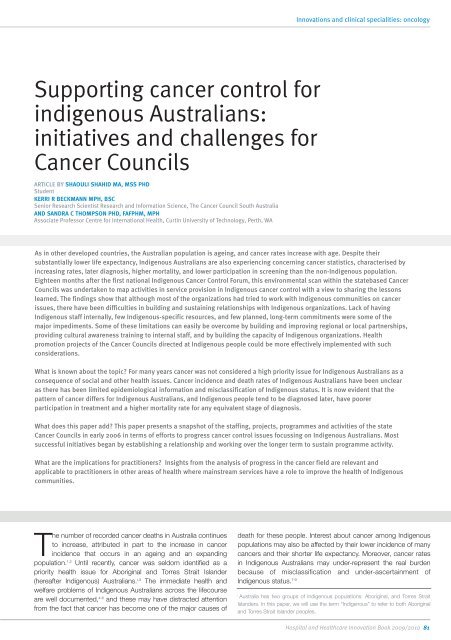Full document - International Hospital Federation
Full document - International Hospital Federation
Full document - International Hospital Federation
You also want an ePaper? Increase the reach of your titles
YUMPU automatically turns print PDFs into web optimized ePapers that Google loves.
Innovations and clinical specialities: oncology<br />
Supporting cancer control for<br />
indigenous Australians:<br />
initiatives and challenges for<br />
Cancer Councils<br />
ARTICLE BY SHAOULI SHAHID MA, MSS PHD<br />
Student<br />
KERRI R BECKMANN MPH, BSC<br />
Senior Research Scientist Research and Information Science, The Cancer Council South Australia<br />
AND SANDRA C THOMPSON PHD, FAFPHM, MPH<br />
Associate Professor Centre for <strong>International</strong> Health, Curtin University of Technology, Perth, WA<br />
As in other developed countries, the Australian population is ageing, and cancer rates increase with age. Despite their<br />
substantially lower life expectancy, Indigenous Australians are also experiencing concerning cancer statistics, characterised by<br />
increasing rates, later diagnosis, higher mortality, and lower participation in screening than the non-Indigenous population.<br />
Eighteen months after the first national Indigenous Cancer Control Forum, this environmental scan within the statebased Cancer<br />
Councils was undertaken to map activities in service provision in Indigenous cancer control with a view to sharing the lessons<br />
learned. The findings show that although most of the organizations had tried to work with Indigenous communities on cancer<br />
issues, there have been difficulties in building and sustaining relationships with Indigenous organizations. Lack of having<br />
Indigenous staff internally, few Indigenous-specific resources, and few planned, long-term commitments were some of the<br />
major impediments. Some of these limitations can easily be overcome by building and improving regional or local partnerships,<br />
providing cultural awareness training to internal staff, and by building the capacity of Indigenous organizations. Health<br />
promotion projects of the Cancer Councils directed at Indigenous people could be more effectively implemented with such<br />
considerations.<br />
What is known about the topic? For many years cancer was not considered a high priority issue for Indigenous Australians as a<br />
consequence of social and other health issues. Cancer incidence and death rates of Indigenous Australians have been unclear<br />
as there has been limited epidemiological information and misclassification of Indigenous status. It is now evident that the<br />
pattern of cancer differs for Indigenous Australians, and Indigenous people tend to be diagnosed later, have poorer<br />
participation in treatment and a higher mortality rate for any equivalent stage of diagnosis.<br />
What does this paper add? This paper presents a snapshot of the staffing, projects, programmes and activities of the state<br />
Cancer Councils in early 2006 in terms of efforts to progress cancer control issues focussing on Indigenous Australians. Most<br />
successful initiatives began by establishing a relationship and working over the longer term to sustain programme activity.<br />
What are the implications for practitioners? Insights from the analysis of progress in the cancer field are relevant and<br />
applicable to practitioners in other areas of health where mainstream services have a role to improve the health of Indigenous<br />
communities.<br />
The number of recorded cancer deaths in Australia continues<br />
to increase, attributed in part to the increase in cancer<br />
incidence that occurs in an ageing and an expanding<br />
population. 1,2 Until recently, cancer was seldom identified as a<br />
priority health issue for Aboriginal and Torres Strait Islander<br />
(hereafter Indigenous) Australians. i, 3 The immediate health and<br />
welfare problems of Indigenous Australians across the lifecourse<br />
are well <strong>document</strong>ed, 4-6 and these may have distracted attention<br />
from the fact that cancer has become one of the major causes of<br />
death for these people. Interest about cancer among Indigenous<br />
populations may also be affected by their lower incidence of many<br />
cancers and their shorter life expectancy. Moreover, cancer rates<br />
in Indigenous Australians may under-represent the real burden<br />
because of misclassification and under-ascertainment of<br />
Indigenous status. 7-9<br />
i<br />
Australia has two groups of Indigenous populations: Aboriginal, and Torres Strait<br />
Islanders. In this paper, we will use the term “Indigenous” to refer to both Aboriginal<br />
and Torres Strait Islander peoples.<br />
<strong>Hospital</strong> and Healthcare Innovation Book 2009/2010 81

















